#surgicalrobotics
Explore tagged Tumblr posts
Text
The Future of Robotics in Medical Equipment: Enhancing Precision and Care
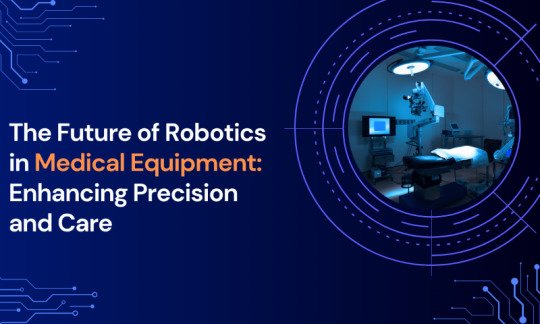
In this generation, the medical field is one of the fields that is going through many technological transitions. Robotics has an important role to play in this as it is setting the boundaries of precision, efficiency, and patient care in both surgical assistance and rehabilitation. This sudden shift will be helpful for top medical equipment manufacturers to develop innovative solutions that can solve complex problems in healthcare industry. This industry is going to change for the good with the integration of robotics in medical equipment.
1. Surgical Robotics
In modern medicine, surgical robotics is experiencing big advancements with time. Robotic surgical systems used in minimally invasive procedures deliver precision, less recovery times, and improved patient outcomes. For improving robotic surgical platforms, top medical equipment manufacturers are trying hard by integrating AI for real-time decision support and augmented reality (AR). This will result in safer and accessible surgeries.
2. Robotics in Rehabilitation and Therapy
In the field of rehabilitation and physical therapy, robotic devices are also going through many changes in multiple ways. Patients can now recover from injuries, strokes, and neurological conditions using exoskeletons and robotic-assisted therapy systems. These devices help in speeding up the recovery process by giving consistent and personalized assistance. Top medical equipment manufacturers are trying to develop more affordable and adaptable robotic rehabilitation devices for making sure that the healthcare facilities are widely accessible even in home settings.
3. Robotic-Assisted Patient Monitoring and Care
As the number of chronic diseases and old-age people are increasing, robotic systems have started to assist with patient monitoring and daily care. Monitoring of vital signs, reminding patients to take medications and alerting healthcare professionals in emergencies can all be done using companion robots that are equipped with sensors and AI. Top medical equipment manufacturers are trying to create scalable solutions for making the smooth integration of these technologies into home care environments possible.
The integration of robotics into medical equipment is set to bring better precision, efficiency, and patient care by 2030. This is not only a challenge but also an extraordinary opportunity for top medical equipment manufacturers to lead in medical innovation.
0 notes
Text

Transforming Surgery With Robotic Technology For All Advanced solutions for the most complicated surgeries
Address - Mawana Road Mussoorie , Meerut Gmail - [email protected] BOOK APPOINTMENT 📲 Contact Us - 1800-313-6064 ,7599221100 website : https://www.valentiscancerhospital.in/
#RoboticSurgery#MedicalInnovation#AdvancedTechnology#SurgicalRobotics#FutureOfHealthcare#MinimallyInvasive#PrecisionMedicine#HealthcareTech#SurgeryRevolution#MedicalBreakthrough
0 notes
Text
2024 Future Innovation: Grapes Innovative Solutions - Robo Space
As we step into 2024, the future of healthcare is on the brink of a transformational leap, and Grapes Innovative Solutions is leading the charge with the Robo Space initiative. With a commitment encapsulated in our tagline, Global Health for All, we aim to revolutionize healthcare access, quality, and delivery through cutting-edge innovations in robotics and artificial intelligence.

A Vision for the Future
The Robo Space mission represents our vision for a world where technology breaks down barriers to healthcare, ensuring that every individual, regardless of location or circumstance, has access to quality care. By merging advanced robotics with smart technology, we can create a more inclusive healthcare ecosystem designed to meet the needs of diverse populations.
What is the Robo Space Mission? The Robo Space Mission is an initiative by Grapes Innovative Solutions focused on integrating advanced robotics and artificial intelligence into healthcare. It aims to enhance surgical precision, improve patient care, and expand access to healthcare through technology.
Key Innovations in the Robo Space Mission
Robotic Surgical Assistance: Our advanced robotic systems are designed to assist surgeons in performing complex procedures with unparalleled precision. This innovation not only enhances surgical outcomes but also reduces recovery times, ultimately benefiting patients and healthcare providers alike.
Telepresence Technology: To bridge the gap between healthcare providers and patients, we’re developing telepresence robots. These robots enable remote consultations, ensuring that individuals in remote or underserved areas have immediate access to healthcare professionals.
AI-Driven Insights: By incorporating artificial intelligence, the Robo Space initiative will harness vast amounts of health data to deliver insights that personalize patient care. This includes predictive analytics for disease prevention and tailored treatment plans that evolve with each patient's unique needs.
Wearable Health Devices: Our mission includes developing smart, wearable devices that continuously monitor health metrics, alerting patients and providers to potential health issues in real time. This proactive approach to health management empowers patients to take control of their healthcare journey.
Robotic Rehabilitation Systems: The Robo Space initiative will introduce robotic exoskeletons designed to aid in rehabilitation, helping patients regain mobility and independence after surgery or injury. These systems promote recovery and improve the quality of life for users.
Commitment to Global Health
With the Global Health for All mission, Grapes Innovative Solutions is dedicated to ensuring that technological advancements reach everyone, regardless of their socio-economic status or geographical location. We believe that healthcare should not be a privilege but a fundamental right. Our innovations aim to democratize access to quality health services and empower individuals to take charge of their health.
Join Us in Shaping the Future
As we embark on this exciting journey in 2024, we invite you to join us. Together, we can work towards a future where healthcare is accessible, efficient, and effective for all. Stay connected with Grapes Innovative Solutions to follow our progress and be part of the Robo Space mission. The future of healthcare is bright, and with innovative solutions, we can make Global Health for All a reality!
FAQ's
1. What is "Grapes Innovative Solutions - Robo Space"? Grapes Innovative Solutions - Robo Space is a cutting-edge platform focused on integrating robotics and AI to revolutionize the agricultural industry, specifically in grape cultivation and harvest automation.
2. How will Robo Space impact the future of grape farming? Robo Space aims to enhance efficiency and sustainability by using robotics to automate tasks like grape picking, monitoring crop health, and optimizing harvest times, ultimately improving yields and reducing labor costs.
3. What makes 2024's innovations in Robo Space unique? The 2024 innovations focus on advanced AI-driven robots that can adapt to different vineyard environments, increase precision in grape picking, and incorporate sustainability practices, paving the way for a more automated and eco-friendly farming future.
For more Get Intouch : Grapes Innovative solutions
Checkout our website: Robo space
Explore more with Our YouTube channel :
#Robosapce#globalhealthforall#FutureOfHealthcare#HealthcareInnovation#MedTech#DigitalHealth#Telemedicine#HealthTech#RoboticsInHealthcare#AIinHealthcare#PatientEngagement#WearableTechnology#PersonalizedMedicine#SurgicalRobotics#Telehealth#HealthData#HealthTechRevolution#HealthcareAccessibility#SmartHealthcare#InnovativeSolutions#HealthCareTransformation#PreventiveCare#RoboticSurgery#ExoskeletonTechnology#PatientExperience#AI#HealthcareTrends
0 notes
Text

🔰 ONUS ROBOCON 2024: Robotic Conference
🎟 2nd Edition - An Update on Robotics in Arthroplasty
🗓 Date: Sunday, 22 December 2024
🕘 Time: 9:00 AM - 5:00 PM IST
📍 Venue: Hotel Taj Deccan, Road No. 1, Banjara Hills, Hyderabad
💻 Click here to register: https://tinyurl.com/OrthoTV-ONUSROBOCON
👨⚕ Live Surgeries: 3 Robotic Surgeries
▪ 6 Relive Surgeries
📚 Learn from the Masters of Arthroplasty
⚠ Limited Seats Available
🌟 Earn 2 TMC Credit Points
Live CORI TKR 👨⚕ Dr. Krishna Kiran
Live Surgery CUVIS Automated TKR 👨⚕ Dr. Balaraaju Naidu
RE LIVE Velys Robotic TKR 👨⚕ Dr. Ratnakar Rao
RE LIVE MAKO TKR 👨⚕ Dr. Suhas Masilamani
RE LIVE MAKO UKR 👨⚕ Dr. Adarsh Annapa Reddy
Live CORI UKR 👨⚕ Dr. Sunil Dachepalli
RE LIVE PIXEE TKR 👨⚕ Dr. K. Sudhir Reddy
RE LIVE MAKO Robotic THR 👨⚕ Dr. Ashok Raju
RE LIVE MISSO Robotic TKR 👨⚕ Dr. K. R. Anil Kumar Reddy
🔹 Featured Robots:• Meril - CUVIS • Smith & Nephew - CORI • Depuy - Velys • Zimmer - ROSA • Stryker - MAKO • Meril - MISSO
👥 TOSA & TCOS Office Bearers• President, TOSA: Dr. Y. Thimma Reddy • President Elect, TOSA: Dr. Ramkumar Reddy • Secretary, TOSA: Dr. Srinivas Kasha • Vice President, TOSA: Dr. Vijaya Bhaskar
👨⚕ Organizing Team• Dr. Balaraju Naidu • Dr. Kartheek Repakula • Dr. P. Madhusudhan • Dr. Ravi Teja Rudraraju
▶ Media Partner : OrthoTV Global
📺 Join OrthoTV - https://linktr.ee/OrthoTV
#ONUSROBOCON2024#RoboticArthroplasty#RoboticSurgery#ArthroplastyConference#JointReplacement#Orthopaedics#OrthopaedicSurgeons#LiveSurgeries#ReliveSurgeries#SurgicalRobotics#MISArthroplasty#TotalKneeReplacement#RoboticTHR#OrthopaedicEducation#MedicalConference#ArthroplastyExperts#TOSA#TCOS#OrthoTV#LimitedSeats
0 notes
Text
Surgical Robotics Market Outlook (2024-2031)
Surgical Robotics Market is expected to reach a CAGR of 13.4% By 2031
Read more:https://shorturl.at/iI4mx

#surgicalrobotics#surgicalroboticsmarketoutlook#surgicalroboticsmarketovreview#surgicalroboticsmarketsize#surgicalroboticsmarketshare
0 notes
Text
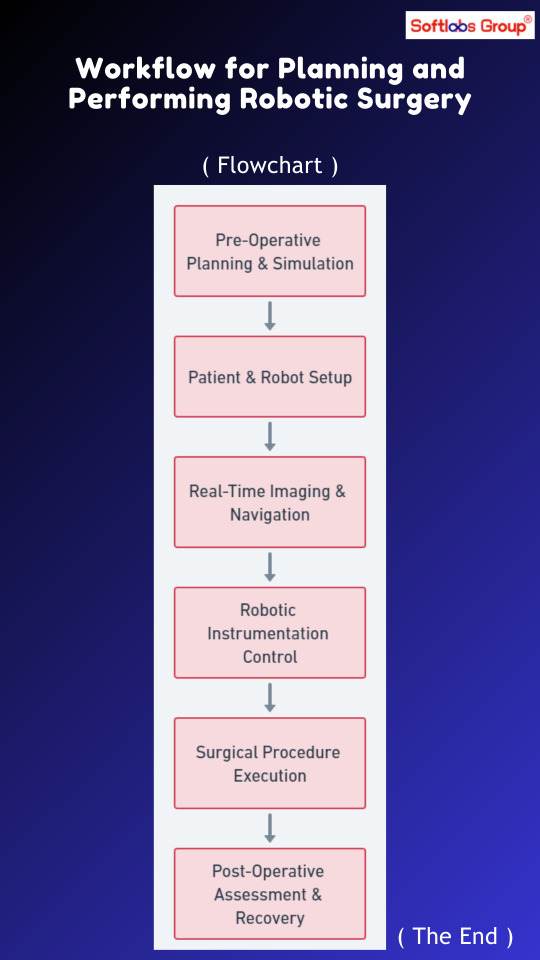
Explore the streamlined workflow of robotic surgery planning and execution. From pre-operative preparation to precise surgical maneuvers, discover how robotics optimize precision, minimize invasiveness, and enhance patient outcomes. Experience the future of surgery with our simplified guide.
0 notes
Text
Unveiling the Future: The Revolutionary Surgical Robotics Market
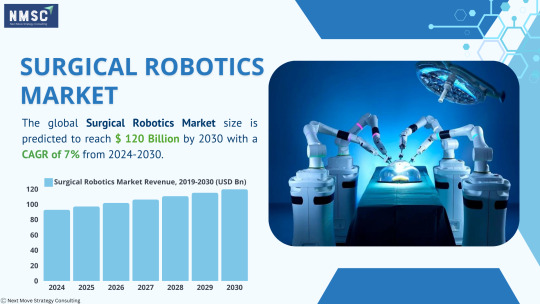
The global healthcare landscape is undergoing a profound transformation, fueled by technological innovations that are reshaping the way medical procedures are performed. At the forefront of this revolution is the field of surgical robotics, which promises to redefine the future of surgery. According to a study by Next Move Strategy Consulting, the global Surgical Robotics Market size is predicted to reach USD 119.67 billion with a CAGR of 7.4% by 2030. In this comprehensive article, we will delve into the intricacies of the surgical robotics market, exploring its evolution, current trends, challenges, and future prospects.
Request for a sample, here: https://www.nextmsc.com/surgical-robotics-market/request-sample
Evolution of Surgical Robotics
The roots of surgical robotics can be traced back to the late 20th century when the first robotic surgical system, known as the PUMA 560, was developed for neurosurgical procedures. Since then, there has been a steady evolution in robotic-assisted surgery, with the introduction of groundbreaking technologies such as the da Vinci Surgical System by Intuitive Surgical in the early 2000s. The da Vinci system, with its advanced capabilities for minimally invasive surgery, marked a significant milestone in the field and paved the way for the widespread adoption of robotic-assisted procedures across various surgical specialties.
Key Drivers of Market Growth
Several factors are driving the growth of the surgical robotics market. One of the primary drivers is the increasing demand for minimally invasive procedures, which offer benefits such as reduced trauma, shorter recovery times, and improved cosmetic outcomes for patients. With a growing emphasis on patient-centered care and quality of life, minimally invasive surgery has emerged as the preferred approach for many surgical interventions.
Furthermore, technological advancements in robotics, imaging, and artificial intelligence (AI) have expanded the capabilities of surgical robots, enabling surgeons to perform complex procedures with greater precision and efficiency. From enhanced imaging modalities for better visualization of surgical targets to AI-powered algorithms for real-time decision support, these innovations are revolutionizing the practice of surgery and opening new possibilities for patient care.
Market Segmentation
The surgical robotics market is segmented based on application, product type, and end-user. In terms of application, robotic-assisted surgery finds use across a wide range of surgical specialties, including urology, gynecology, orthopedics, cardiovascular surgery, and general surgery. Each specialty presents unique challenges and opportunities for robotic-assisted procedures, driving the development of specialized robotic platforms tailored to specific surgical needs.
Product-wise, the market is dominated by the da Vinci Surgical System, which remains the gold standard in robotic-assisted surgery. However, there is growing competition from other players entering the market with their own robotic platforms, offering innovative features and functionalities designed to address unmet needs in surgical practice.
In addition to hospitals and surgical centers, academic institutions and research laboratories play a crucial role in driving innovation in surgical robotics. Collaborative research efforts between industry and academia are essential for advancing the field and developing next-generation robotic technologies that meet the evolving needs of surgeons and patients alike.
Regional Landscape
The adoption of surgical robotics varies across different regions, influenced by factors such as healthcare infrastructure, regulatory environment, reimbursement policies, and cultural attitudes towards technology. While developed markets such as North America and Europe have been early adopters of robotic-assisted surgery, emerging economies in Asia Pacific and Latin America are also witnessing rapid growth in demand for robotic platforms.
In countries including China and India, rising healthcare expenditures, increasing prevalence of chronic diseases, and government initiatives to improve healthcare access are driving the adoption of surgical robotics. However, challenges such as affordability, accessibility, and the availability of trained personnel pose barriers to widespread adoption in these regions.
Challenges and Opportunities
Despite the significant progress made in the field of surgical robotics, several challenges remain that need to be addressed to realize the full potential of this technology. One of the primary challenges is the high cost of robotic systems, which can be prohibitive for many healthcare institutions, especially in resource-constrained settings. Additionally, there is a need for standardized training programs to ensure that surgeons are proficient in robotic-assisted techniques and can perform procedures safely and effectively.
Inquire before buying, here: https://www.nextmsc.com/surgical-robotics-market/inquire-before-buying
Moreover, regulatory approval processes for new robotic platforms can be lengthy and complex, delaying their introduction to the market and hindering innovation. Streamlining regulatory pathways and fostering collaboration between regulatory agencies, industry stakeholders, and healthcare providers is essential for expediting the development and adoption of new robotic technologies.
Despite these challenges, the surgical robotics market presents significant opportunities for growth and innovation. Continued investment in research and development, along with strategic partnerships and collaborations, will drive the development of next-generation robotic platforms with enhanced capabilities and expanded applications. Furthermore, initiatives to improve patient access to robotic-assisted surgery, such as reimbursement reforms and telemedicine programs, will help address disparities in healthcare delivery and ensure equitable access to advanced surgical care.
Future Outlook
Looking ahead, the future of the surgical robotics market appears promising, with continued advancements in technology, expanding applications, and growing acceptance among surgeons and patients. As robotic platforms become more sophisticated and affordable, their adoption is expected to increase across a broader range of surgical specialties and healthcare settings. Additionally, the integration of AI, machine learning, and data analytics into robotic systems will further enhance their capabilities for personalized, precision medicine.
Furthermore, the ongoing digital transformation of healthcare, fueled by trends such as remote monitoring, telemedicine, and virtual reality, will create new opportunities for innovation in surgical robotics. From remote surgical consultations to augmented reality-guided procedures, technology-enabled solutions will revolutionize the way surgery is performed and experienced by patients and healthcare providers.
In conclusion, the revolutionary advancements in surgical robotics are poised to reshape the future of surgery, offering unprecedented precision, efficiency, and patient outcomes. With the global surgical robotics market projected to reach new heights in the coming years, stakeholders across the healthcare ecosystem must collaborate to overcome challenges and harness the full potential of this transformative technology. By embracing innovation and leveraging the power of robotics, we can unlock new possibilities for surgical care and improve the lives of patients around the world.
#surgicalrobotics#healthcare#innovation#lifesciences#biotechnology#AI#marketresearch#markettrends#businessinsights
0 notes
Text
Robotics Surgery - Achievement, gaps and future direction
First robotic liver transplant in U.S. performed by Washington University surgeons Yes, Its a milestone moment in #MedicalRobotics Liver transplant procedure is considered complex and sensitive invasive process due to fear of excessive bleeding in removing diseased liver and requires specialized skill attaching new liver for delicately sewing several tiny blood vessels together. Its a…

View On WordPress
#artificialintelligence#emergingtechnology#Healthcare#Hospitals#livertransplant#machinelearning#medicaldevices#medicalrobotics#Robotics#surgery#surgicalrobotics
0 notes
Text
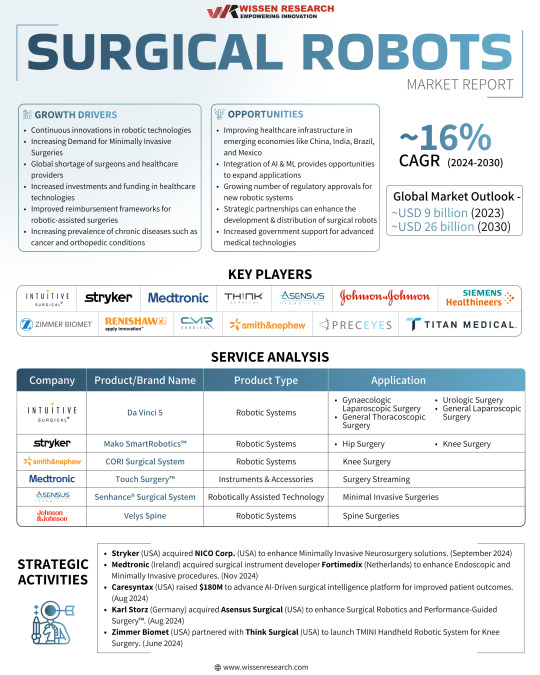
The global 𝐒𝐮𝐫𝐠𝐢𝐜𝐚𝐥 𝐑𝐨𝐛𝐨𝐭𝐬 𝐌𝐚𝐫𝐤𝐞𝐭 is estimated to be valued at ~ USD 9 Billion in 2023 and is projected to reach ~ USD 26 Billion by 2030. The market is expected to grow at a CAGR of ~16% during the forecast period 2024-2030. Click the link to access the 𝐒𝐮𝐫𝐠𝐢𝐜𝐚𝐥 𝐑𝐨𝐛𝐨𝐭𝐬 𝐌𝐚𝐫𝐤𝐞𝐭 report: https://www.wissenresearch.com/global-surgical-robots-market-2030/ 𝐊𝐞𝐲 𝐏𝐥𝐚𝐲𝐞𝐫𝐬 • INTUITIVE SURGICAL (US) • STRYKER CORPORATION (US) • MEDTRONIC PLC (IRELAND) • SMITH AND NEPHEW (UK) • ASENSUS SURGICAL INC. (US) • JOHNSON & JOHNSON • SIEMENS HEALTHINEERS AG (GERMANY) • ZIMMER BIOMET (US) • RENISHAW PLC (UK) • CMR SURGICAL (UK) • THINK SURGICAL INC. (US) • TITAN MEDICAL INC. (CANADA) • PRECEYES BV (NETHERLANDS) 𝐒𝐭𝐫𝐚𝐭𝐞𝐠𝐢𝐜 𝐀𝐜𝐭𝐢𝐯𝐢𝐭𝐢𝐞𝐬 • Medtronic (Ireland) acquired surgical instrument developer Fortimedix (Netherlands) to enhance Endoscopic and Minimally Invasive procedures. (Nov 2024) • Stryker (USA) acquired NICO Corp. (USA) to enhance Minimally Invasive Neurosurgery solutions. (September 2024) • Caresyntax (USA) raised $180M to advance AI-Driven surgical intelligence platform for improved patient outcomes. (Aug 2024) • Karl Storz (Germany) acquired Asensus Surgical (USA) to enhance Surgical Robotics and Performance-Guided Surgery™. (Aug 2024) 𝐅𝐨𝐫 𝐦𝐨𝐫𝐞 𝐝𝐞𝐭𝐚𝐢𝐥𝐬 𝐚𝐧𝐝 𝐩𝐞𝐫𝐬𝐨𝐧𝐚𝐥𝐢𝐳𝐞𝐝 𝐢𝐧𝐬𝐢𝐠𝐡𝐭𝐬, 𝐫𝐞𝐚𝐜𝐡 𝐨𝐮𝐭 𝐭𝐨 𝐮𝐬 𝐭𝐨𝐝𝐚𝐲! Request for customized 𝐒𝐮𝐫𝐠𝐢𝐜𝐚𝐥 𝐑𝐨𝐛𝐨𝐭𝐬 𝐌𝐚𝐫𝐤𝐞𝐭:- https://www.wissenresearch.com/ask-for-customization/ 𝐂𝐨𝐧𝐭𝐚𝐜𝐭 𝐔𝐬: https://www.wissenresearch.com/contact/
#SurgicalRobots#MedicalTechnology#HealthcareInnovation#RobotSurgery#CAGRGrowth#SurgicalRobotsMarket#KeyPlayers#MinimallyInvasiveNeurosurgery#WissenResearch#MarketForecast
0 notes
Text
Tiny surgical robots could transform detection and treatment of cancers

Tiny surgical robots could transform detection and treatment of cancers. A tiny robot which can travel deep into the lungs to detect and treat the first signs of cancer has been developed by researchers at the University of Leeds. The ultra-soft tentacle, which measures just 2 millimeters in diameter and is controlled by magnets, can reach some of the smallest bronchial tubes and could transform the treatment of lung cancer. It paves the way for a more accurate, tailored, and far less invasive approach to treatment and has been developed by engineers, scientists and clinicians based at the STORM Lab in Leeds. The researchers tested the magnetic tentacle robot on the lungs of a cadaver and found that it can travel 37% deeper than the standard equipment and leads to less tissue damage. The results of their investigations, are published in Engineering Communications. "This is a really exciting development. This new approach has the advantage of being specific to the anatomy, softer than the anatomy and fully-shape controllable via magnetics. These three main features have the potential to revolutionize navigation inside the body." Professor Pietro Valdastri, Director of the STORM Lab and research supervisor, said Lung cancer has the highest worldwide cancer mortality rate. In early-stage non-small cell lung cancer, which accounts for around 84% of cases, surgical intervention is the standard of care. However, this is typically highly invasive and leads to the significant removal of tissue. This approach is not suitable for all patients and can have an impact on lung function.

A close up of the phantom lung and the magnetic tentacle robot. Credit: STORM Lab, University of Leeds Lung cancer screening programs have led to better survival rates but have also highlighted the urgent need to find non-invasive ways to diagnose and treat patients early. As well as improving navigation within the lungs during biopsies, the magnetic tentacle robot could pave the way for far less invasive treatment, allowing clinicians to target only malicious cells while allowing healthy tissue and organs to continue normal function. The report's co-author, Dr. Giovanni Pittiglio, who carried out the research while conducting his PHD at the University of Leeds's School of Electronic and Electrical Engineering, added, "Our goal was, and is, to bring curative aid with minimal pain for the patient. "Remote magnetic actuation enabled us to do this using ultra-soft tentacles which can reach deeper, while shaping to the anatomy and reducing trauma." The team will now set about collecting all the data that will allow them to start human trials. https://youtu.be/UrKa_IAm67k
How magnetic tentacle robots can work together
Researchers at the STORM Lab have also been investigating ways of controlling two independent magnetic robots so that they can work together in a confined area of the human anatomy, allowing one to move a camera and the other to control a laser to remove tumors. The devices are made of silicone to minimize tissue damage and are steered by magnets mounted on robotic arms outside the patient's body. Using a replica of a skull, the team successfully trialed the use of two robots to carry out endonasal brain surgery, a technique which allows a surgeon to go through the nose to operate on areas at the front of the brain and the top of the spine. The researchers needed the magnetic robots to move independently of each other so that one could move the camera, while the other could direct a laser onto a tumor. Normally, two magnets placed closely together would attract each other, creating a challenge for the researchers. They overcame it by designing the bodies of the tentacles in a way that they can bend only in specific directions and by relocating the north and south poles in each magnetic robot tentacle.

First demonstration of bimanual magnetic soft robots for skull-base surgery. Credit: STORM Lab, University of Leeds They were then able to simulate the removal of a benign tumor on the pituitary gland at the base of the cranium, proving for the first time ever that it is possible to control two of the robots in one confined area of the body. The findings of their research is published in Advanced Intelligent Systems. The paper's lead author, Zaneta Koszowska, a researcher in the University of Leeds School of Electronic and Electrical Engineering, said, "This is a significant contribution to the field of magnetically controlled robotics. "Our findings show that diagnostic procedures with a camera, as well as full surgical procedures, can be performed in small anatomical spaces." More information: Giovanni Pittiglio et al, Personalized magnetic tentacles for targeted photothermal cancer therapy in peripheral lungs, Communications Engineering (2023). DOI: 10.1038/s44172-023-00098-9 Zaneta Koszowska et al, Independently Actuated Soft Magnetic Manipulators for Bimanual Operations in Confined Anatomical Cavities, Advanced Intelligent Systems (2023). DOI: 10.1002/aisy.202300062 Source: University of Leeds Read the full article
0 notes
Text
🏗️ Precision Surgical Robotics: Market to Hit $10.5B by 2034
Precision Robotics for Surgery Market is revolutionizing healthcare by introducing advanced robotic systems designed to enhance surgical precision, efficiency, and patient outcomes. This sector includes robotic-assisted devices, surgical planning software, and post-operative analytics, aiming to minimize invasiveness, increase accuracy, and reduce recovery times. These advancements are transforming traditional surgical procedures, offering significant improvements in patient care and operational efficiency in healthcare facilities worldwide.
To Request Sample Report: https://www.globalinsightservices.com/request-sample/?id=GIS11057 &utm_source=SnehaPatil&utm_medium=Article
Driven by technological progress and the growing demand for minimally invasive procedures, the market is expanding rapidly. The orthopedic surgery segment currently leads the market, propelled by the rising prevalence of musculoskeletal disorders and the need for highly precise surgical interventions. Cardiovascular surgery follows closely, as the increasing incidence of heart diseases and the demand for precise surgeries drive growth. Geographically, North America dominates the market, owing to its advanced healthcare infrastructure and high adoption rate of innovative technologies. Europe, particularly countries like Germany and the United Kingdom, is also witnessing substantial growth, as healthcare systems integrate more robotic solutions. Meanwhile, the Asia-Pacific region is poised for rapid growth due to increasing healthcare investments and rising awareness of the benefits of robotic surgery.
In 2023, the market reached a significant volume, with surgical robotics capturing a 45% market share, followed by robotic-assisted surgeries at 30% and minimally invasive systems at 25%. The adoption of robotic systems in orthopedic and cardiovascular procedures has been pivotal in driving this growth.
Key players like Intuitive Surgical, Stryker Corporation, and Medtronic are at the forefront, leading innovations and forging strategic partnerships. As AI and machine learning are integrated into surgical robotics, the market is set to grow further, with a projected annual growth rate of 10% over the next decade.
#SurgicalRobotics #PrecisionSurgery #RoboticSurgery #MinimallyInvasive #OrthopedicSurgery #CardiovascularSurgery #MedTech #AIinHealthcare #RoboticsInMedicine #HealthcareInnovation #MedicalTechnology #SurgeryInnovation #Telemanipulation #RoboticSystems #AdvancedSurgery #PostOperativeCare #HealthTech #RoboticAssistance #SurgicalPrecision #FutureOfSurgery #HealthcareEfficiency #MedicalDevices #SurgicalPlanning #RoboticArms #StrykerCorporation #IntuitiveSurgical #Medtronic
0 notes
Text

🔰 ONUS ROBOCON 2024: Robotic Conference
🎟 2nd Edition - An Update on Robotics in Arthroplasty
🗓 Date: Sunday, 22 December 2024
🕘 Time: 9:00 AM - 5:00 PM IST
📍 Venue: Hotel Taj Deccan, Road No. 1, Banjara Hills, Hyderabad
💻 Click here to register: https://tinyurl.com/OrthoTV-ONUSROBOCON
👨⚕ Live Surgeries: 2 Robotic Surgeries
📚 Learn from the Masters of Arthroplasty
⚠ Limited Seats Available
🌟 Earn 2 TMC Credit Points
🔹 Featured Robots:• Meril - CUVIS • Smith & Nephew - CORI • Depuy - Velys • Zimmer - ROSA • Stryker - MAKO • Meril - MISSO
👥 TOSA & TCOS Office Bearers• President, TOSA: Dr. Y. Thimma Reddy • President Elect, TOSA: Dr. Ramkumar Reddy • Secretary, TOSA: Dr. Srinivas Kasha • Vice President, TOSA: Dr. Vijaya Bhaskar • Treasurer, TOSA: Dr. K. Ramesh • Joint Secretary, TOSA: Dr. Raja Ramesh Badavath • President, TCOS: Dr. N. Srinivasan • Secretary, TCOS: Dr. R. Suneel
👨⚕ Organizing Team• Dr. Balaraju Naidu • Dr. Kartheek Repakula • Dr. P. Madhusudhan • Dr. Ravi Teja Rudraraju
▶ Media Partner : OrthoTV Global
📺 Join OrthoTV - https://linktr.ee/OrthoTV
#ONUSRobocon2024#RoboticConference2024#OrthopaedicRobotics#RoboticSurgery#ArthroplastyInnovation#SurgicalRobotics#FutureOfSurgery#OrthoRobotics#HyderabadEvents#BanjaraHills#TOSA#TCOS#OrthoTV#LiveSurgery#LearnFromTheBest#RegisterNow#MedicalEducation#CME#TMCPoints#SurgeryMasterclass
0 notes
Text
Surgical Robotics Market Outlook (2024-2031)
Surgical Robotics Market is expected to reach a CAGR of 13.4% By 2031
Read more:https://shorturl.at/iI4mx

#surgicalrobotics#surgicalroboticsmarketoutlook#surgicalroboticsmarketovreview#surgicalroboticsmarketsize#surgicalroboticsmarketshare
0 notes
Text
Advanced Robotic Joint Replacement Surgery in Mumbai
Experience the future of joint replacement surgery in Mumbai with our advanced robotic technology. Our skilled surgeons deliver precision and accuracy for better outcomes. Schedule a consultation today.
For more information : https://boneandjointcare.co.in/robotic-joint-replacement-surgery/
#RoboticSurgeryMumbai#JointReplacement#AdvancedTechnology#MedicalInnovation#SurgicalRobotics#MumbaiHealthcare#OrthopedicSurgery#MinimallyInvasive#FutureOfMedicine#PrecisionSurgery
0 notes
Text
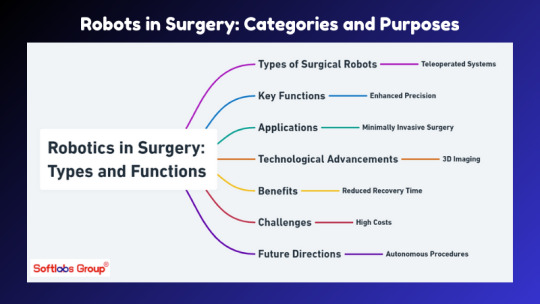
Dive into the world of Robotics in Surgery: Types and Functions! Discover how robotic technology is transforming surgical procedures, from minimally invasive techniques to precise movements. Explore different types of surgical robots and their diverse functions, enhancing surgeon capabilities and patient outcomes. Join us on the forefront of medical innovation as we explore the future of surgery.
0 notes
Text
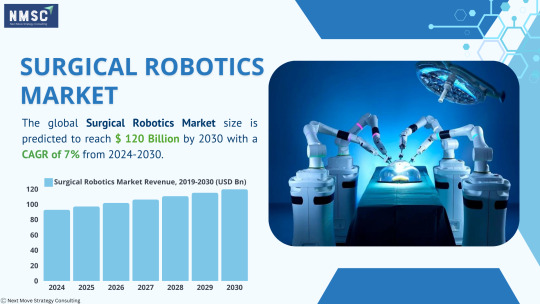
𝐄𝐱𝐩𝐥𝐨𝐫𝐢𝐧𝐠 𝐭𝐡𝐞 𝐒𝐮𝐫𝐠𝐢𝐜𝐚𝐥 𝐑𝐨𝐛𝐨𝐭𝐢𝐜𝐬 𝐌𝐚𝐫𝐤𝐞𝐭
𝐆𝐞𝐭 𝐚 𝐅𝐑𝐄𝐄 𝐒𝐚𝐦𝐩𝐥𝐞: https://www.nextmsc.com/surgical-robotics-market/request-sample?utm_source=sanyukta-28-march-24&utm_medium=sanyukta-tumblr&utm_campaign=sanyukta-surgical-robotics-market
Excited to delve into the revolutionary advancements in the surgical robotics market!
Let's take a closer look at the evolving landscape:
𝐇𝐢𝐬𝐭𝐨𝐫𝐢𝐜𝐚𝐥 𝐏𝐞𝐫𝐬𝐩𝐞𝐜𝐭𝐢𝐯𝐞: Surgical robotics has come a long way since its inception. From early prototypes to sophisticated systems, the journey has been remarkable. The integration of AI, machine learning, and advanced imaging has propelled the field forward.
𝐂𝐮𝐫𝐫𝐞𝐧𝐭 𝐒𝐭𝐚𝐭𝐞: Today, surgical robotics is not just a concept but a reality shaping the healthcare industry. With increased precision, minimal invasiveness, and faster recovery times, these systems are transforming surgical procedures across various specialties.
𝐌𝐚𝐫𝐤𝐞𝐭 𝐆𝐫𝐨𝐰𝐭𝐡: The global surgical robotics market continues to witness significant growth, driven by factors such as rising demand for minimally invasive surgeries, technological advancements, and increasing investments in healthcare infrastructure.
𝐊𝐞𝐲 𝐈𝐧𝐧𝐨𝐯𝐚𝐭𝐢𝐨𝐧𝐬: Innovations in surgical robotics are reshaping the way surgeries are performed. From intuitive interfaces to haptic feedback systems, these advancements are enhancing surgical outcomes and patient experiences.
𝐒𝐩𝐞𝐜𝐢𝐚𝐥𝐭𝐲 𝐅𝐨𝐜𝐮𝐬: The impact of surgical robotics extends across a wide range of specialties, including orthopedics, neurosurgery, urology, and gynecology. Each field presents unique challenges and opportunities for innovation.
𝐅𝐮𝐭𝐮𝐫𝐞 𝐎𝐮𝐭𝐥𝐨𝐨𝐤: Looking ahead, the future of surgical robotics is filled with promise. Continued advancements in AI, robotics, and telemedicine are expected to further enhance the capabilities of these systems, expanding their reach and accessibility.
𝐈𝐧𝐝𝐮𝐬𝐭𝐫𝐲 𝐂𝐨𝐥𝐥𝐚𝐛𝐨𝐫𝐚𝐭𝐢𝐨𝐧: Collaboration between healthcare providers, technology companies, and regulatory bodies is essential to drive innovation and ensure the safe and effective integration of surgical robotics into clinical practice.
𝐆𝐥𝐨𝐛𝐚𝐥 𝐑𝐞𝐚𝐜𝐡: The impact of surgical robotics is not limited by geographical boundaries. With increasing adoption worldwide, these technologies are improving healthcare delivery and patient outcomes on a global scale.
𝐌𝐚𝐫𝐤𝐞𝐭 𝐩𝐥𝐚𝐲𝐞𝐫𝐬: Medtronic plc, Smith & Nephew Plc. (Blue Belt Technologies, Inc.), Intuitive Surgical, Inc., Auris Surgical Robotics, Inc. (Hansen Medical Inc.), Stryker Corporation (MAKO Surgical Corp.), Renishaw plc, KUKA AG, Mazor Robotics, Zimmer Biomet Holdings Inc. and THINK Surgical Inc. among others.
Join the Conversation! What are your thoughts on the future of the surgical robotics market? Share your insights and experiences in the comments below!
#surgicalrobotics #healthcareinnovation #medicaltechnology #futureofhealthcare #aIinSurgery #marketresearch #markettrends #businessinsights
0 notes